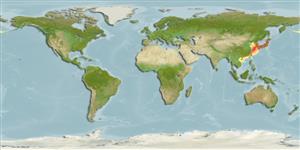Environment: milieu / climate zone / depth range / distribution range
Ökologie
seewasser demersal; tiefenbereich 0 - 200 m (Ref. 43239), usually 0 - 20 m (Ref. 43239). Temperate
Northwest Pacific: Japan and Korea (Ref. 37630).
Length at first maturity / Size / Gewicht / Alter
Maturity: Lm ?, range 15 - ? cm
Max length : 30.0 cm SL Männchen/unbestimmt; (Ref. 559)
Kurzbeschreibung
Bestimmungsschlüssel | Morphologie | Morphometrie
Rückenflossenstacheln (insgesamt) : 76 - 83; Rückenflossenweichstrahlen (insgesamt) : 0; Afterflossenstacheln: 2; Afterflossenweichstrahlen: 35 - 42; Wirbelzahl: 83 - 90.
Facultative air-breathing in the genus (Ref. 126274); Found in tide pools or the intertidal zone to 20 m depth, on sandy-mud bottoms and among rocks of rocky reefs (Ref. 43239); also in eelgrass (Zostera marina) beds (Ref. 559). Sometimes to 200 m depth (Ref. 43239). Feeds on gammarids. Juveniles associate with drifting seaweed (Ref. 12114, 12115). Although rarely used for commercial food, this species is highly valued as fried fish in the spring months in Tokyo and neighboring areas (Ref. 7031).
Life cycle and mating behavior
Maturities | Fortpflanzung | Spawnings | Egg(s) | Fecundities | Larven
Nakabo, T., 2002. Fishes of Japan with pictorial keys to the species, English edition II. Tokai University Press, Japan, pp 867-1749. (Ref. 43239)
IUCN Rote Liste Status (Ref. 130435)
Bedrohung für Menschen
Harmless
Nutzung durch Menschen
Tools
Zusatzinformationen
Download XML
Internet Quellen
Estimates based on models
Preferred temperature (Ref.
123201): 13.2 - 22.7, mean 18.3 °C (based on 94 cells).
Phylogenetic diversity index (Ref.
82804): PD
50 = 0.5005 [Uniqueness, from 0.5 = low to 2.0 = high].
Bayesian length-weight: a=0.00257 (0.00157 - 0.00420), b=3.27 (3.13 - 3.41), in cm total length, based on LWR estimates for this species & (Sub)family-body (Ref.
93245).
Trophic level (Ref.
69278): 3.2 ±0.32 se; based on food items.
Generation time: 1.5 ( na - na) years. Estimated as median ln(3)/K based on 1
growth studies.
Widerstandsfähigkeit (Ref.
120179): hoch, Verdopplung der Population dauert weniger als 15 Monate. (K=0.7).
Fishing Vulnerability (Ref.
59153): Low vulnerability (22 of 100).
